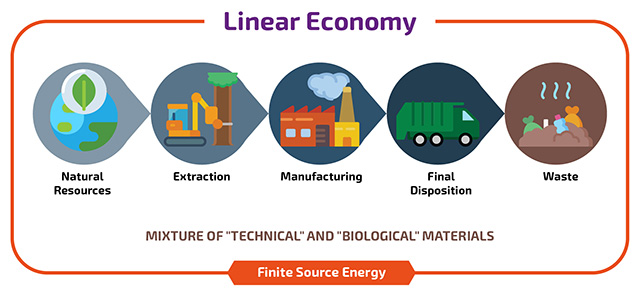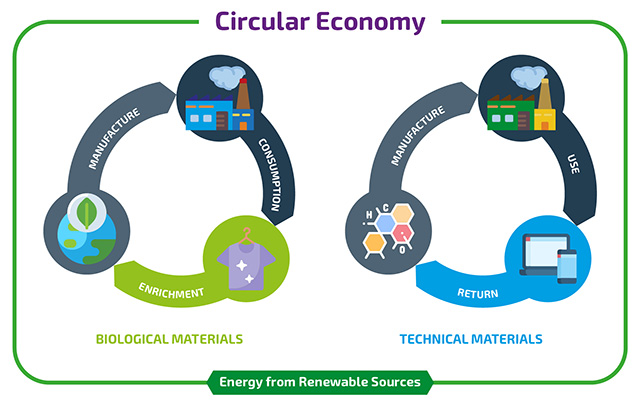by Giovanna Canever and Ralph Menezes.
By analyzing weather events that have recently occurred around the world, such as snow in southern Brazil, temperatures close to 50°C in the Canadian summer, floods in Germany and forest fires in Siberia, it is noticeable that global warming and climate change are increasing. increasingly affecting the lives of the population. It is noteworthy that the Greenhouse Effect is a natural phenomenon, and that its occurrence is inevitable on the planet, however, the way of life adopted by humanity, with the use of fossil fuels on a large scale, contributes to the acceleration of this phenomenon. In this regard, it is up to us, as a society, to seek alternatives to mitigate the effects of our own consumption habits.
Among the existing possibilities, there is the transformation of our economic activities from a linear to a circular process.


In circular economies, unlike linear economies, the residues from processes and resulting from consumption are reused and can be used as an input for various production chains and even as fuel for electricity generation. This reuse results in several benefits, especially for the environment.
Projects that transform municipal solid waste into heat, steam, electricity or gaseous or liquid fuels are known as Waste-to-Energy (WtE), and existing technologies can be applied to semi-solid, liquid, gaseous and solid urban waste (MSW), being the most common application. Currently, the most well-known MSW processing technology is incineration through plants that generate heat and electricity.
However, for the implementation of these projects to be viable, economic incentives are needed from the municipal, state and federal governments. The operating cost of a WtE unit is much higher than that of a landfill, and with the current value of energy in Brazil, the revenue from the sale of EE and heat does not offset the investment and O&M costs of the plant. To become viable, some incentive with an environmental focus is needed. Some possibilities are:
- increase the value of EE from WtE, with purchase obligation for polluting industries
- grounding cost fee
- direct incentive for destination to WtE instead of landfill
- obligation to install WtE for municipalities and consortia serving regions with more than X inhabitants
But how is the generation of electrical energy through WtE technologies?
The use of solid waste can occur through combustion, anaerobic digestion and gasification.
- Combustion: recovery of thermal energy generated by burning waste. Heat heats a boiler and steam drives a turbine coupled to the generator. The use of MSW combustion contributes to a reduction in the volume of waste sent to landfills by up to 95% and to a reduction in the emission of greenhouse gases. However, the operation can become unfeasible with low calorific value waste and there is a high O&M cost.
- Anaerobic digestion: it is a biochemical process carried out in digesters, in which matter is degraded by anaerobic microorganisms in the absence of oxygen. As a result, there is the production of biogas and compounds. It is the process that naturally takes place in a landfill. The biogas produced from the process is generally used in internal combustion engines coupled to generators to produce electricity.
- Gasification: the waste is heated to temperatures above 700º C in an environment with little oxygen, so that combustion does not occur. The resulting gas from the process can then be used for power generation.
Com o intuito de mudar essa realidade e recuperar energia do lixo urbano e industrial, garantindo uma alternativa ao descarte dos resíduos, algumas iniciativas vem sendo tomadas. Após a aprovação do novo marco regulatório do saneamento, deferido pelo Congresso, o MME passou a habilitar usinas que utilizam resíduos sólidos urbanos (lixo) para participação dos leilões regulados de energia.
According to an article published by O Globo in May 2021, around 96% of waste goes to landfills, without any type of treatment. In a mapping carried out by the Brazilian Association for Energy Recovery of Waste (Abren), around 80 million tons of garbage could be used as fuel for the generation of electricity. It is estimated that 120 generating units could produce electricity from garbage generated in metropolitan regions with more than 1 million inhabitants, totaling an installed capacity of up to 2,358 MW. In addition to the generation of energy and the enormous contribution to the environment, there is also the generation of employment and income, with around 24,000 jobs in the construction phase and around 9,000 for the operation of the projects.
It is also highlighted here the costs that garbage represents for city halls. According to the Abren mapping, Brazilians produce 1 kg of garbage per day and this implies a cost of R$ 2.4 billion in environmental issues per year.
At the moment, the cost of generating energy from RSU is still expensive as it is a source under development in Brazil. However, with the incentive through public policies and the development of new technologies, it is estimated that the costs for this source will reduce over the years, further increasing the viability of these projects.
Conheça os nossos serviços e veja como a Simple Energy pode ajudar a maximizar sua economia e receita de energia elétrica.
Subscribe to our Newsletter and stay on top of news in the electricity sector!
BE SINGULAR. BE SIMPLE.





2 comments
Regina
October 4, 2021 at 2:54 am
Matéria de uma valiosa contribuição para a solução do lixo em forma de energia, assim será de grande valor para as cidades , população e indústrias, com algo politicamente correto sendo aproveitado para minimizar custos e gerar cada vez mais energia. Parabéns!!!
Admin Simple
January 27, 2023 at 11:52 am
Olá, Regina. Obrigado por seu comentário.
Sim, há muitas alternativas que podem contribuir por um mundo mais limpo e sustentável para todos nós.
Saudações do time Simple!